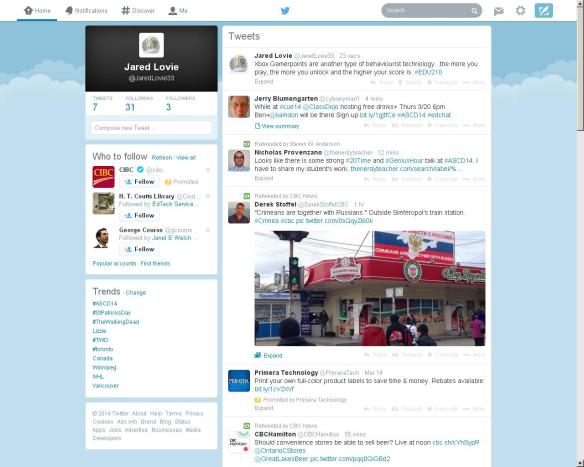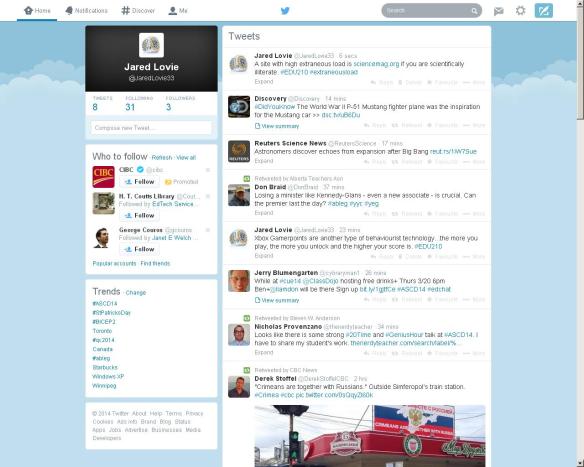In Module 10, we focused on the variety of theories that exist with respect to technology in learning and teaching. The first, behaviorism, focuses on repetition, rewards and punishments, and the conditioning of the student to modify their behavior (such as the typing challenge undertaken in class) (Burk, 2014). The second, cognitivism, focused on chunking content and working off prior knowledge (such as the word quest undertaken in class). The third, connectivism, directs students to people and resources where they may obtain the information they are looking for. A good example of connectivism is Twitter. Fourth, constructivism, is based on discovery-based learning. Learning is reinforced through experiential activities designed to allow students to learn organically. A good example of this was the sum of the entire activity undertaken in class.
A couple more technology theories analyzed were media ecology, technology directing human proclivities, and the social construction of technology, the creation of technology based upon human needs (Burk, 2014). Below, I have posted a variety of Twitter screenshots with respect to various learning theories. Further, I have included a reflection on learning and teaching theories.
Module 10 – Technology in Learning and Teaching Theories
Part A: PLN Learning Theory Posts
Behaviorist
Above is the screenshot of my tweet about an additional behaviourist technology.
Cognitive Load – Extraneous Load
Constructivism
Constructivism vs. Connectivism
Part B: Learning Technology and Theories Reflection
Throughout Module 10, I’ve had an opportunity to think and reflect on how I learn best. I certainly can appreciate the different learning theories, behaviorism, constructivism, cognitivism, and connectivism, and I can certainly recognize that these ideas have been presented in an idealized fashion – one which compartmentalizes these ideas as if they operate independently and that students can be funneled into one of these four categories (Burk, 2014). Students (and all learners) are incredibly unique and draw their ability to learn from all four learning theories. I firmly believe that a learning outcome, not explicitly stated, for post-secondary education is the ability to recognize your own epistemology. My epistemology is one that is centered around constructivism. I learn best when I’m provided with information, which I can then apply to a real-life situation or some sort of hands-on activity (Fung, 2012). I was able to recognize this trait back in Grades 7, 8, and 9 when I had the opportunity to partake in an Alberta Education pilot program called the Youth Apprenticeship Project (YAP). YAP was a project designed to infuse the trades, kinaesthetic, and vocational learning into the core curriculum through the junior high grades in order to transition students into the high school Registered Apprenticeship Program (RAP) and to provide them with an incentive to graduate. When I entered the YAP, I was coded by Alberta Education as a code 80 student (Alberta Education, 2008). With the help of some excellent teaching (I would love to list all of my teachers, however I’m limited by a word count), I was allowed to flourish and really appreciate the education I received. I look back at my time in YAP fondly and I am a huge proponent of this program and its benefits for students.
As for technology in the classroom, three specific ways teachers can use technology to provide a constructivist classroom include giving the students the freedom to pursue an individualized research project, providing students with a new or innovative technological resource and having them demonstrate how to best utilize said resource, and giving students the opportunity to learn a programming language and allowing them to create something that best represents themselves or their interests. With respect to the first method, teachers would provide students with the knowledge required to properly conduct research for a project and how to properly demonstrate evidence of learning to their peers. Students would be free to use the resources at their disposal to research a topic that interests them, but they must demonstrate their evidence of learning through a current technological method, such as a poster they have developed online or a podcast. With respect to the second method, teachers would gather a list of new, trendy technological resources, such as the latest social media network or the newest, most powerful search engine, and have students play around with the tool and learn its capacities and limitations, and then present that to the class or submit an assignment on it. Third, teachers could provide students with a list of the variety of programming languages available. Students could then choose what language they would like to learn and then could design a website or create a video game, for example, with the knowledge they’ve accrued in order to demonstrate their learning.
References
Alberta Education. (2008). Special education coding criteria 2008/2009. Edmonton, AB: Alberta Education.
Burk, A. (2014, March 18). Technology in learning and teaching theories. EDU 210 Introduction to Educational Technology. Lecture conducted from University of Alberta, Edmonton, AB.
Fung, P. (2012). Mind map of learning theories. Mindmeister.com. Retrieved March 24, 2014, from http://www.mindmeister.com/78275435/mind-map-of-learning-theories.




